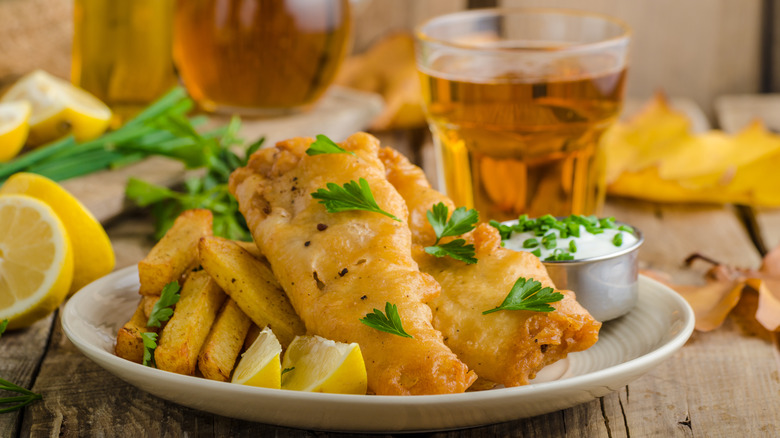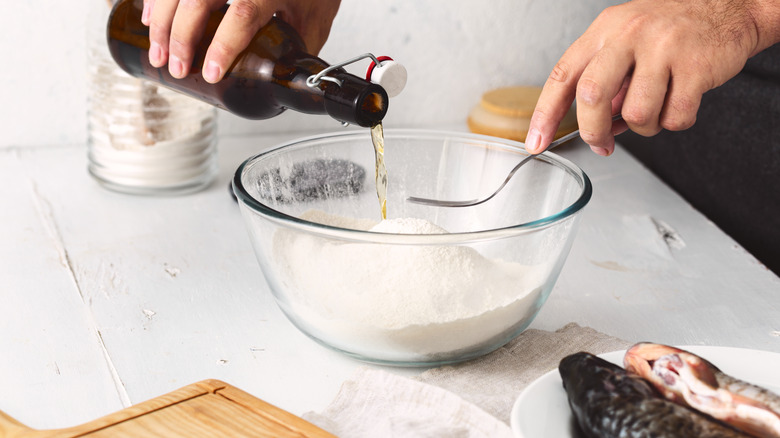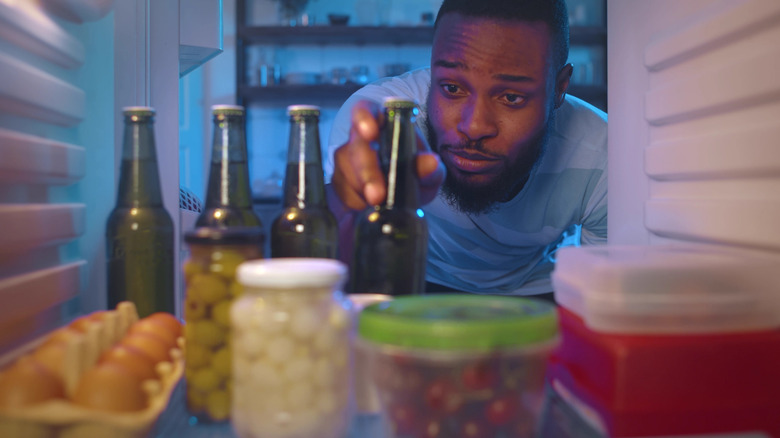What Does The Beer In Beer Batter Actually Do?
Beer is a supremely versatile beverage, not only in the sense that it comes in an endless amount of styles and varieties to sip on but also in the sense that you can do so much more than sip on it. Beer can be a key player in both cooking and baking by adding moisture, depth, and flavor to many different types of recipes.
Beer batter certainly isn't a foreign concept; it's on many restaurant menus by way of fish and chips or onion rings, and maybe you've even made beer-battered creations at home. Beer is a common ingredient in the battering of many of those pub-style fried foods we love, but do we know why use beer, specifically? What does it actually do to the batter that makes for a better final product? Like everything in cooking, there's a reason it's used as an ingredient, and there's a science behind why it works so well. Let's get to the bottom of it and see what brew can do.
Why beer and batter are better together
Typically, beer batter is made by adding beer to a mixture of flour, seasonings, and sometimes eggs to create a thick substance that resembles a pancake batter. This thick consistency allows for the protection of softer, more fragile foods (like fish) while they fry – but the beer also adds flavor, encourages that beautiful browning, and all the while keeps the batter light enough to crisp up into a lovely, airy texture.
Why does beer have these desirable effects on fried food? According to Scientific American, it comes down to three things that beer brings to the mix: Foaming agents, alcohol, and carbon dioxide.
The foaming agents in beer act as insulators in the batter that takes in the high heat of the hot oil, allowing what's inside to gently cook to perfection while the outside becomes crispy and golden brown. The alcohol allows this process to happen quickly, without overcooking anything, because alcohol evaporates faster than other liquids. And the carbon dioxide, aka the beer's carbonation, is arguably the most important factor – its bubbles work double-time to both expand the batter into a lacy texture and keep the batter extra light and tender by limiting the amount of gluten that forms in the flour mixture. All of these things work together to make beer and batter the perfect match for light, crispy fried foods.
Keep a beer in the fridge for elevated recipes
Whether you consider yourself a beer drinker or not, this hoppy, carbonated beverage can go a long way in the kitchen and has so many potential uses in your favorite recipes.
If you want to cook with beer, try adding some to your next batch of chili, stew, or pot of soup. It will add a deeper, earthier layer of flavor to savory dishes like this as opposed to water or stock. Beer pairs great with all kinds of meats, whether you use it to marinate a steak, to braise shredded pork, or even to stuff inside a chicken like this beer can chicken recipe. And you can bake with beer, too! Try adding it to bread or cookies for extra fluff and tenderness, or step up your next chocolate cake with a malty stout or porter.
As far as which beer to use for which recipes, a good rule of thumb is that lighter beers like lager and wheat beer will pair best with lighter foods like seafood and chicken, while heavier ales and stouts will work better with heartier meats (like pork, beef, and lamb) and for baking bread or rich, chocolatey desserts.


